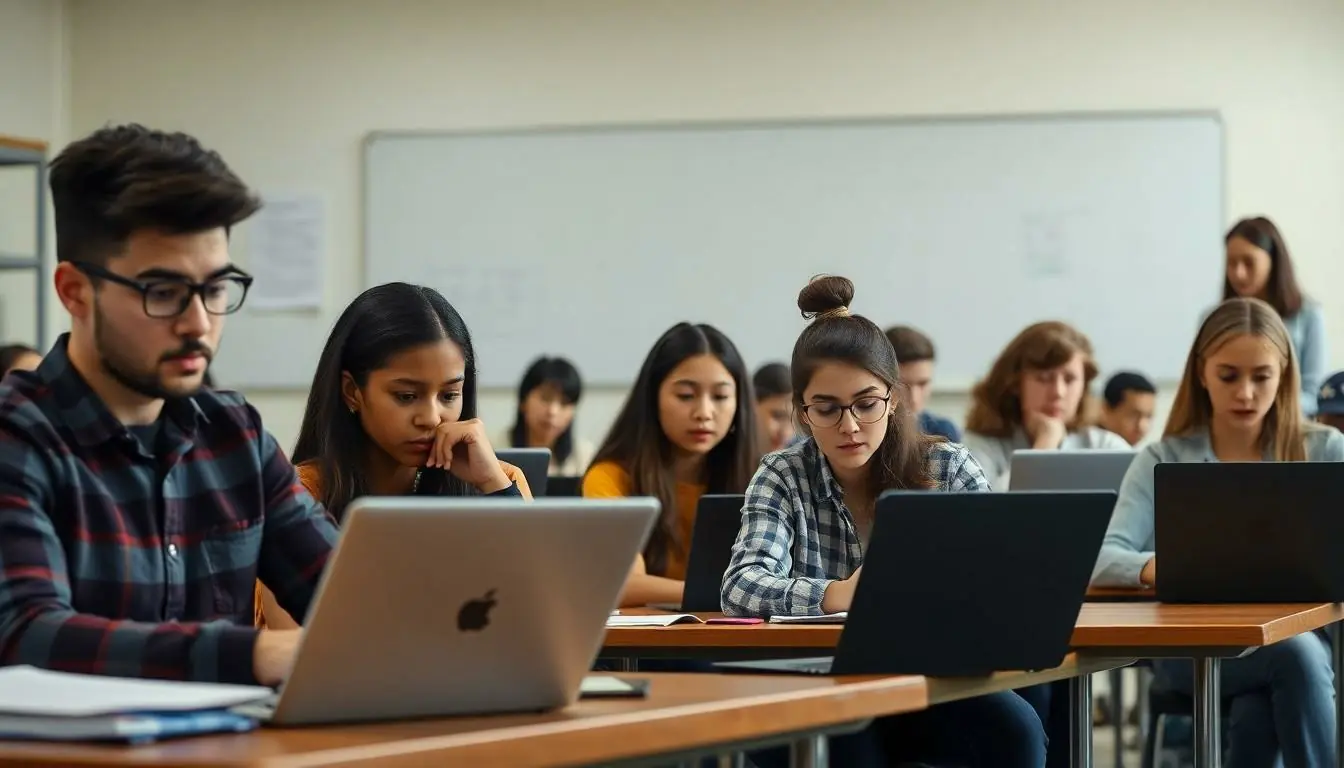Table of Contents
ToggleIn today’s tech-savvy classrooms, educators face a new challenge: the rise of AI writing tools like ChatGPT. While these tools can be a boon for creativity, they can also lead to some sneaky shortcuts. How can teachers tell if a student’s essay is a masterpiece crafted by their own hand or a polished product of AI wizardry?
Understanding ChatGPT and Its Use in Education
ChatGPT serves as a powerful AI writing tool, contributing to educational environments. Many students leverage its capabilities to generate text quickly. Due to its rapid growth, it’s crucial for educators to recognize both its advantages and its potential misuses.
Educators observe increased creativity when students utilize ChatGPT. It enables users to explore diverse writing styles and perspective shifts. This exposure can enhance students’ writing skills and broaden their understanding of topics. However, the convenience of AI-generated content raises concerns regarding academic integrity.
Identifying AI-generated work becomes increasingly important. Teachers can look for specific markers that indicate potential use of tools like ChatGPT. Unnatural writing patterns might emerge, such as inconsistencies in tone or style. Additionally, content that lacks deep analysis or personal insight can signal the use of AI. Moreover, unusually high word counts for assigned tasks may suggest an over-reliance on AI assistance.
Understanding how to navigate this issue empowers educators. They can educate students about responsible use of AI tools, emphasizing the importance of developing original thought. Encouraging a blend of AI assistance and personal input fosters skill development. By integrating discussions of AI in classrooms, teachers create an environment that values creativity alongside integrity.
As students adapt to the evolving landscape of AI technologies, educators also need to adapt their assessment methods. Recognizing the signs of AI assistance in student work helps maintain academic standards. Therefore, incorporating awareness of tools like ChatGPT can reinforce integrity in educational settings.
Identifying Signs of ChatGPT Usage

Identifying signs of ChatGPT usage helps educators distinguish between student-generated content and AI-assisted writing. Several markers indicate potential AI involvement.
Inconsistencies in Writing Style
Students often exhibit inconsistencies in writing style when utilizing ChatGPT. Sudden shifts in tone, vocabulary, or structure frequently signal AI usage. For example, an essay might begin with a personal voice but transition to formal language, creating a disconnect. Frequent changes in paragraph length or complexity further raise red flags. Unusual transitions between ideas may also occur, often lacking coherence. Monitoring these variations allows educators to determine if AI contributed to the writing process.
Unusual Content Quality
Unusual content quality can indicate the influence of ChatGPT. Essays may contain well-structured sentences yet lack depth in analysis or critical thinking. Students utilizing AI might provide surface-level responses rather than insightful arguments, showcasing a lack of personal engagement with the topic. Overly verbose or complex sentences may appear, masking simpler ideas that would typically surface in authentic work. Examining the quality of content against expected student capabilities helps educators identify potential AI-generated material.
Tools and Techniques for Detection
Educators can apply various tools and techniques to identify student use of ChatGPT in their writing. A combination of traditional and advanced detection methods offers a robust approach.
Plagiarism Detection Software
Plagiarism detection software, such as Turnitin and Grammarly, serves as a reliable first step in identifying potential AI-generated content. These platforms analyze text and compare it to extensive databases of existing work. They highlight similarities and flag instances of copied material. Educators should interpret high similarity scores with caution, as they can indicate AI assistance rather than outright plagiarism. Incorporating these tools can provide insights, but they may not specifically target AI-generated text patterns.
AI-Specific Detection Tools
AI-specific detection tools, like GPT-2 Output Detector and Copyleaks, focus on identifying writing generated by AI models. These tools evaluate text for patterns characteristic of AI-generated content, such as unusual word choices or phrasing. By analyzing the likelihood that a text originated from a language model, they offer a unique layer of scrutiny. Educators can use these specialized tools to complement traditional methods and gain a clearer understanding of student writing origins.
Best Practices for Educators
Educators can adopt several practices to effectively address the challenges posed by AI writing tools in their classrooms.
Creating Original Assignments
Original assignments can help minimize the likelihood of students relying on AI-generated content. Crafting prompts that require personal reflection encourages unique responses. Assignments that mandate specific formats or integrate local context foster a deeper connection to the material. Incorporating collaborative projects promotes peer interaction, often leading to more authentic outputs. Frequent updates to assignment topics can also reduce familiarity with AI responses, pushing students to engage critically with the content.
Encouraging Honest Communication
Open communication channels establish trust between educators and students. When teachers clarify the importance of academic integrity, students often feel motivated to be truthful about their work. Providing a safe space for discussions about AI usage is also beneficial, as it empowers students to seek help when needed. Encouraging students to share their writing struggles can foster collaboration and reduce dependence on AI tools. Regular check-ins can reinforce the expectation of honesty and remind students of the value of their original ideas.
Navigating the challenges posed by AI writing tools like ChatGPT requires a proactive approach from educators. By understanding the signs of AI-generated content and employing both traditional and advanced detection methods, teachers can uphold academic integrity.
Creating assignments that encourage personal expression and fostering open communication about AI usage can significantly reduce reliance on these tools. As students adapt to new technologies, educators must also adapt their strategies to ensure a balance between creativity and integrity. Embracing this evolving landscape will not only enhance learning but also prepare students for a future where AI plays an integral role in writing and communication.






